Birds play an important role in maintaining the ecological balance around the world. Mindoro, an island in the Philippines, is home to a diverse range of bird species.
Boasting of vast forests, mountain ranges, and coastal areas, Mindoro provides an ideal habitat for these feathered creatures. The island is a paradise for birdwatchers and nature enthusiasts, with a variety of endemic, migratory, and rare bird species.
From hawks to kingfishers, Mindoro’s birdlife brings color and melody to its natural environment. In this article, we will explore the fascinating world of birds in Mindoro and gain insights into what distinguishes them from the rest of their feathered counterparts.
1. Philippine Megapode
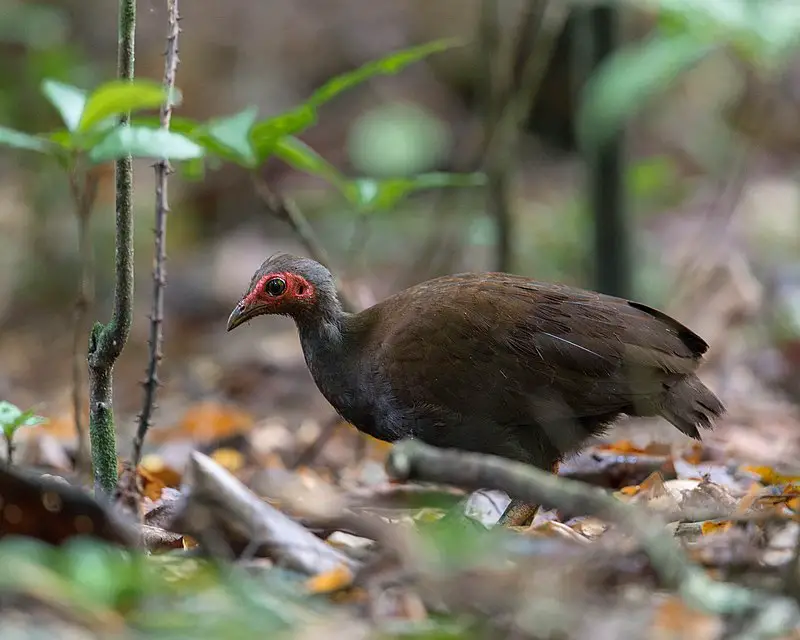
The Philippine Megapode is a species of bird found in the Philippines, northeastern Borneo and Sulawesi. It has an overall brown body colour with dark barring on its wings and tail feathers.
Its head is covered by light grey downy feathers while its legs are yellowish-orange in colour.
This ground dwelling bird prefers to inhabit subtropical or tropical dry forest, moist lowland forest as well as montane forests where it feeds on fruits, insects and small animals amongst other things.
As far as reproduction goes this species builds mound nests using materials such as leaves, twigs and soil which can reach up to four meters long.
They then lay their eggs within these mounds for incubation where the heat generated from decomposing vegetation helps keep them warm until they hatch a few months later into young chicks ready to explore their surroundings further.Scientific classification:
| Kingdom | Animalia |
| Phylum | Chordata |
| Class | Aves |
| Order | Galliformes |
| Family | Megapodiidae |
| Genus | Megapodius |
| Species | M. cumingii |
Also Featured In: Birds of the Philippines,
2. Pied Triller
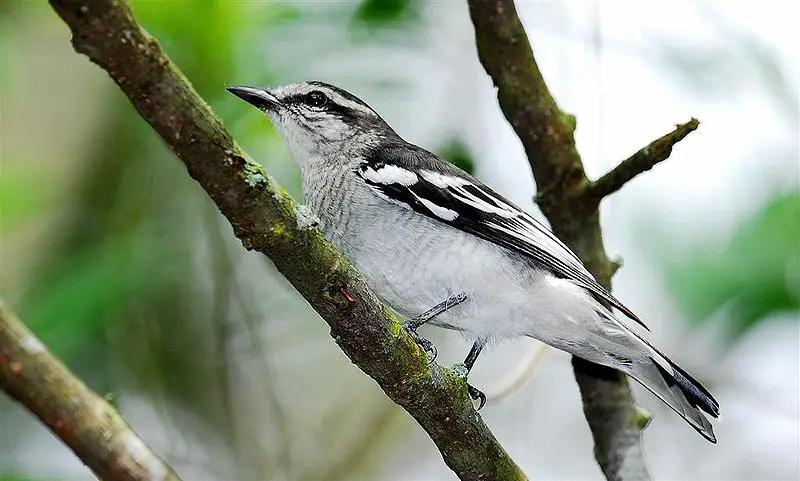
The Pied Triller is a species of bird found in parts of South East Asia. It belongs to the family Campephagidae and can be seen in Brunei, India, Indonesia, Malaysia, Philippines, Singapore and Thailand.
This black-and-white passerine has an eye patch that sets it apart from other birds its size. Its underparts are white with rufous upperparts and wings as well as grey crowns on both males and females giving them a unique look.
They mainly feed on insects but have also been observed eating fruits from trees or shrubs occasionally.
In terms of habitat they prefer forests but can adapt to secondary growth habitats too if needed for survival purposes making them quite adaptive creatures indeed.Scientific classification:
| Kingdom | Animalia |
| Phylum | Chordata |
| Class | Aves |
| Order | Passeriformes |
| Family | Campephagidae |
| Genus | Lalage |
| Species | L. nigra |
Also Featured In: HDB Approved by Birds,
3. Yellow-Breasted Fruit Dove
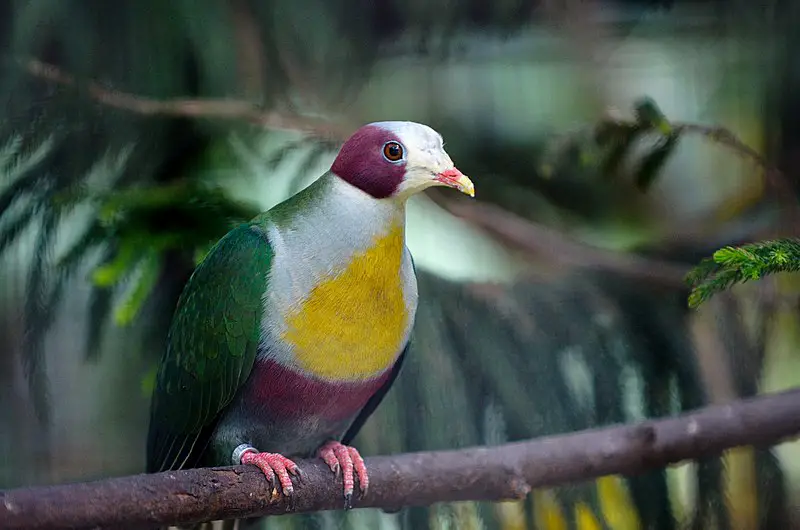
The Yellow-breasted fruit dove is a beautiful bird endemic to the Philippines. It lives in tropical moist lowland forests, however its population is declining due to habitat loss and illegal hunting or trapping for the wildlife trade.
This species has been listed as Least Concern by IUCN but conservation efforts are still needed if we want this species of bird survive.
The yellow-breasted fruit Dove has an overall yellowish colour with dark wings and tail feathers, red eyes and white spot on each side of their neck.
They feed mainly on fruits such as figs and berries which makes them important seed dispersers in their natural habitats while they also drink flower nectar like hummingbirds do.
Its illegal to hunt, capture or keep this lovely little creature so let’s all work together towards protecting it from extinction.Scientific classification:
| Kingdom | Animalia |
| Phylum | Chordata |
| Class | Aves |
| Order | Columbiformes |
| Family | Columbidae |
| Genus | Ptilinopus |
| Species | P. occipitalis |
4. Barred Rail
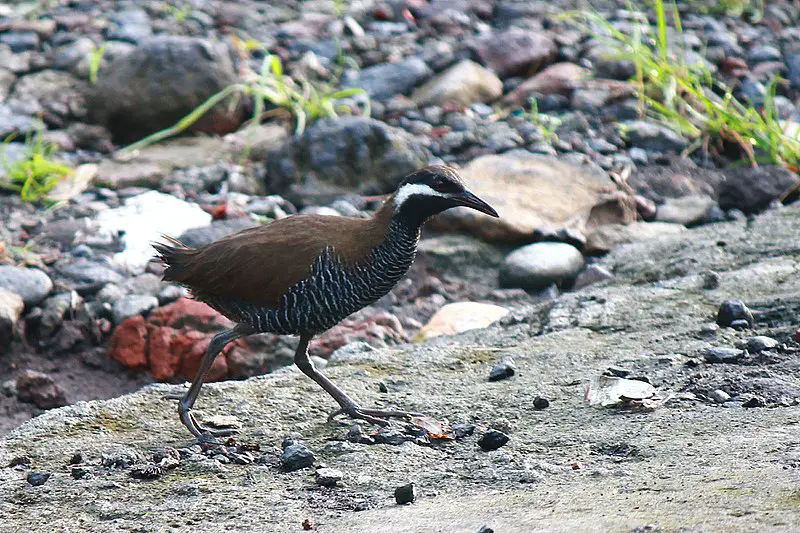
The Barred Rail is a species of rail found in the Philippines, Sulawesi and Salawati. It has distinct barred black and white feathers, making it easily identifiable.
This bird is common but shy, so it can be difficult to spot during its natural habitat. It prefers wet habitats such as marshes or rice fields that provide plenty of cover for them to hide from potential predators.
While their diet consists mainly of small invertebrates like earthworms and insects, they�ve also been known to feed on seeds and grains when food sources are scarce.
Though not endangered yet, human activity continues to reduce these birds’ already limited habitats across the region which may put them at risk if conservation efforts aren’t taken soon enough.Scientific classification:
| Kingdom | Animalia |
| Phylum | Chordata |
| Class | Aves |
| Order | Gruiformes |
| Family | Rallidae |
| Genus | Hypotaenidia |
| Species | H. torquata |
5. Philippine Pygmy Woodpecker
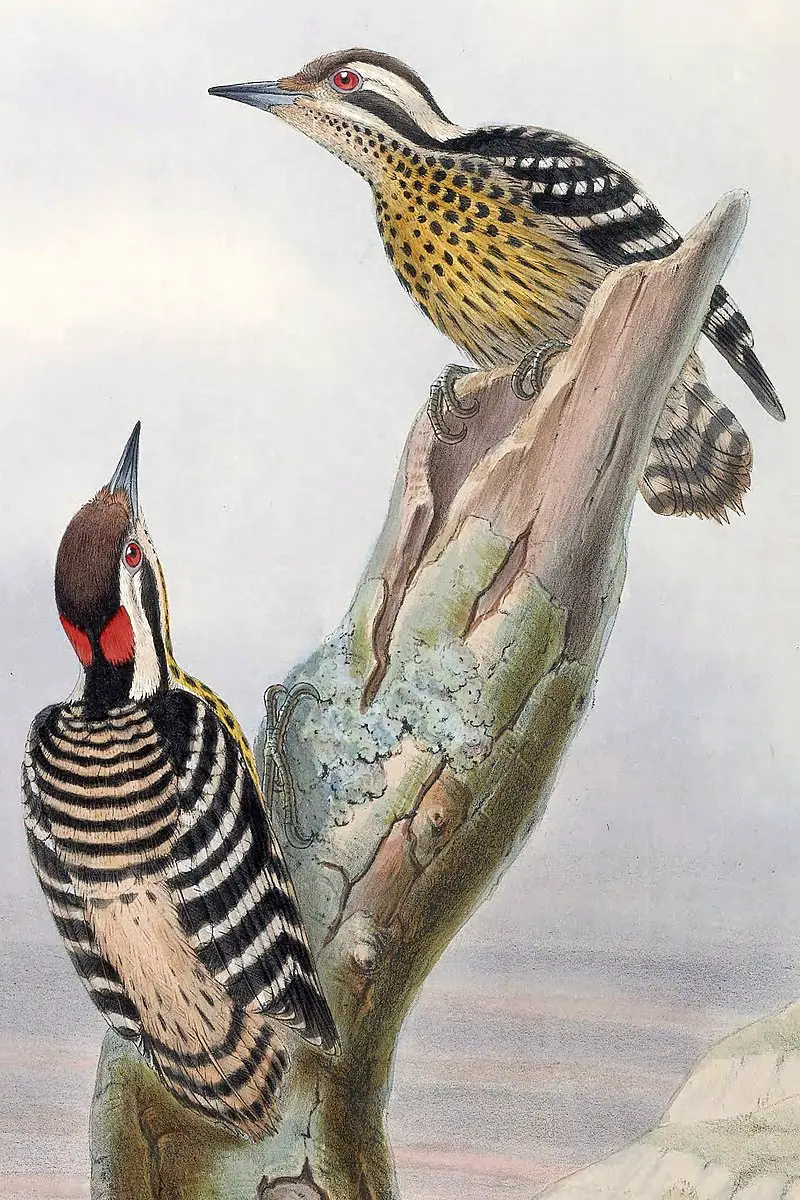
The Philippine pygmy woodpecker is a small species of bird in the Picidae family. It has three different subspecies, validirostris, maculatus and menagei.
These birds have blackish-brown feathers on their back that are moderately barred with white stripes, as well as a white throat which features a dark spot.
In Kapampangan they are called Anluage. They can be seen living in forests and woodlands mostly around the Philippines but also parts of Indonesia and Malaysia where there is suitable habitat for them to survive; such habitats include mangroves and coastal areas.
The Philippine pygmy woodpecker does not migrate due to its size so it remains within its area even during winter times when food sources become scarce or difficult to find because of snowfall or lack thereof.Scientific classification:
| Kingdom | Animalia |
| Phylum | Chordata |
| Class | Aves |
| Order | Piciformes |
| Family | Picidae |
| Genus | Yungipicus |
| Species | Y. maculatus |
6. Philippine Hanging Parrot
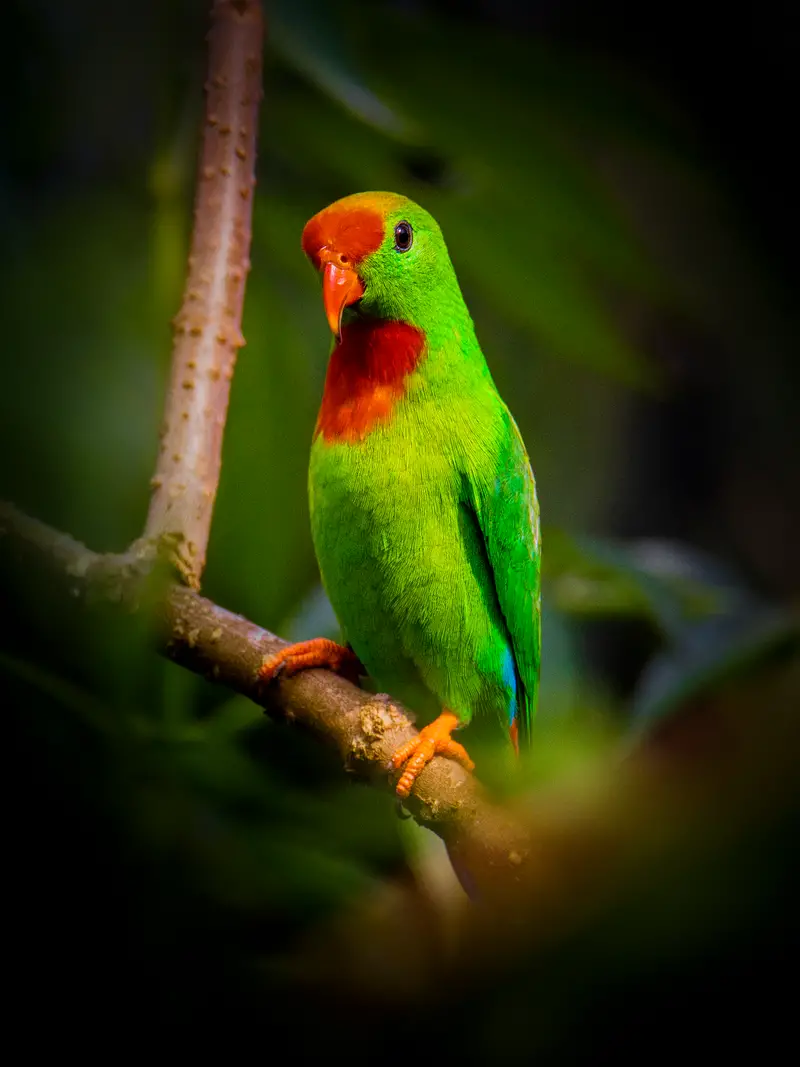
The Philippine Hanging Parrot is a small, psittaculid parrot species found in the Philippines. It has 11 subspecies, one of which may be distinct from the others.
The bird is known by its local Tagalog name ‘Kulasisi’. This beautiful bird can usually be seen hanging upside down on thin branches or vines and feeds mainly on fruits and flowers.
Despite being listed as Least Concern by IUCN, some of its subspecies are under threat due to deforestation and illegal trapping for pet trade.
Conservation efforts must therefore be taken to ensure their survival in the wild.Scientific classification:
| Kingdom | Animalia |
| Phylum | Chordata |
| Class | Aves |
| Order | Psittaciformes |
| Family | Psittaculidae |
| Genus | Loriculus |
| Species | L. philippensis |
7. Plain Bush-Hen
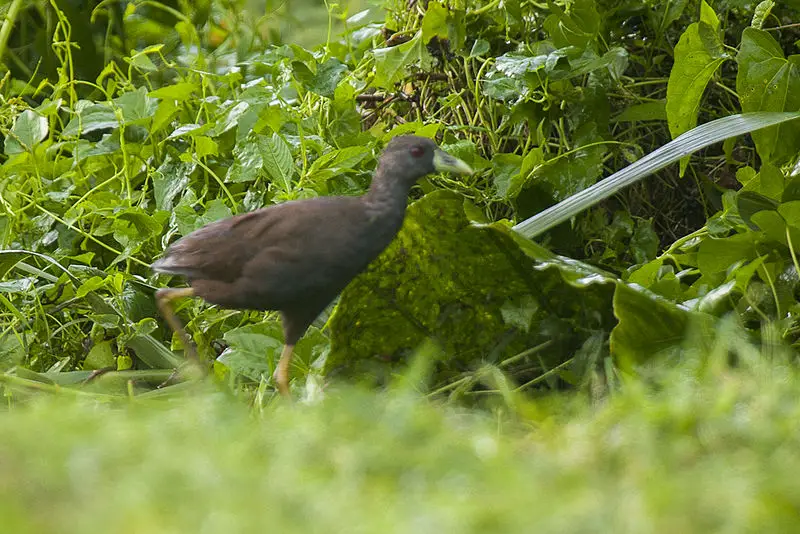
The Plain bush-hen is a species of bird in the Rallidae family, found only in The Philippines. It has an olive-brown color with pale yellow underparts and black barring on its wings, tail and head.
Its bill is short and thick while legs are long for wading through shallow water to find food like small invertebrates, seeds or fruits.
They usually stay close to bodies of water such as swamps or marshes where they can hide from predators by standing very still among tall grasses or vegetation when danger approaches.
During breeding season males attract females with loud calls repeated several times throughout the day which help them pair up easily but nest sites remain hidden since these birds build their nests low on ground next to dense bushes providing excellent camouflage against potential threats.Scientific classification:
| Kingdom | Animalia |
| Phylum | Chordata |
| Class | Aves |
| Order | Gruiformes |
| Family | Rallidae |
| Genus | Amaurornis |
| Species | A. olivacea |
8. Black-Chinned Fruit Dove
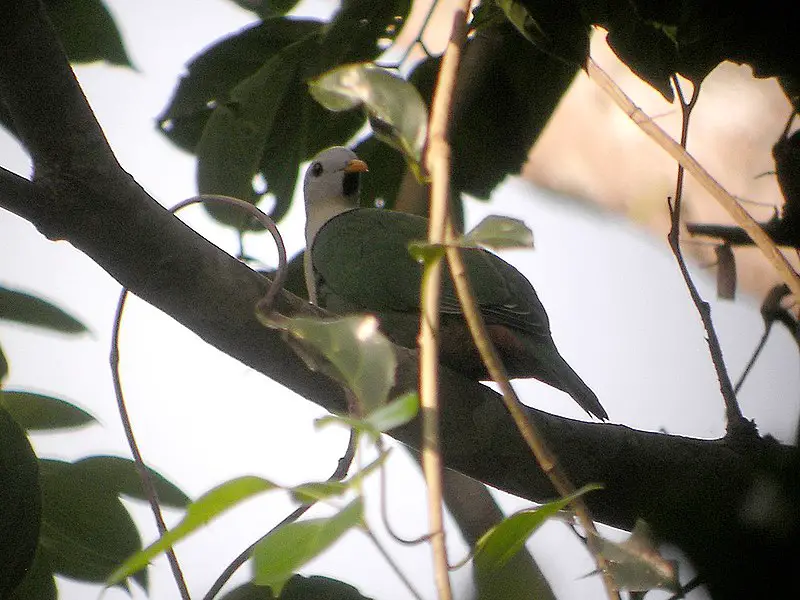
The Black-chinned Fruit Dove is a stunningly beautiful bird with its vibrant colors and unique features.
Males have green bellies, wings, and tails; whitish grey heads and necks with purple bases; red irises; yellow bills with small black patches underneath.
Females have green heads, necks, backs of the head to the tail feathers which are dark brown in color.
This species can grow up to 27 cm long making it medium sized for a dove species. They inhabit lowland forests from northern India throughout Southeast Asia as far north as Taiwan where they feed on fruits like figs along with some insects too.
These birds usually travel alone or in pairs during their migrations but flocks may also form when food sources become available at certain times of year.Scientific classification:
| Kingdom | Animalia |
| Phylum | Chordata |
| Class | Aves |
| Order | Columbiformes |
| Family | Columbidae |
| Genus | Ptilinopus |
| Species | P. leclancheri |
Also Featured In: Most Common Birds of Lubang Island, Beautiful Birds Found in Coron Island
9. Thick-Billed Flowerpecker
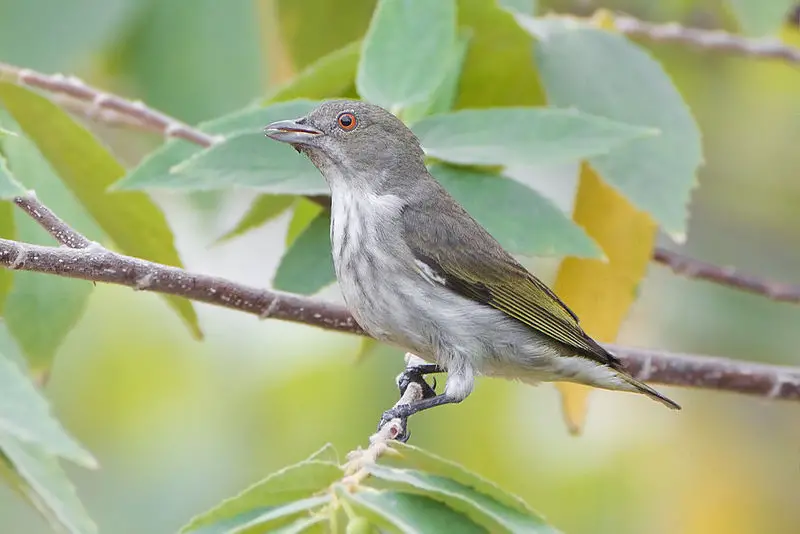
The Thick-billed Flowerpecker is a tiny bird that belongs to the flowerpecker group. It has a wide distribution across tropical southern Asia, ranging from India east to Indonesia and Timor.
They are active birds found in the tops of trees in forests and they predominantly feed on fruits.
This species is also considered as resident with several populations recognized as subspecies, some of which may be treated as their own separate species at times.
These little birds have bright plumage making them quite attractive while they search for food amongst tree canopies or fly around looking for insects or nectar sources.Scientific classification:
| Kingdom | Animalia |
| Phylum | Chordata |
| Class | Aves |
| Order | Passeriformes |
| Family | Dicaeidae |
| Genus | Dicaeum |
| Species | D. agile |
Also Featured In: Timor-Leste birds, Common Birds that Live in Odisha
10. Tawny Grassbird
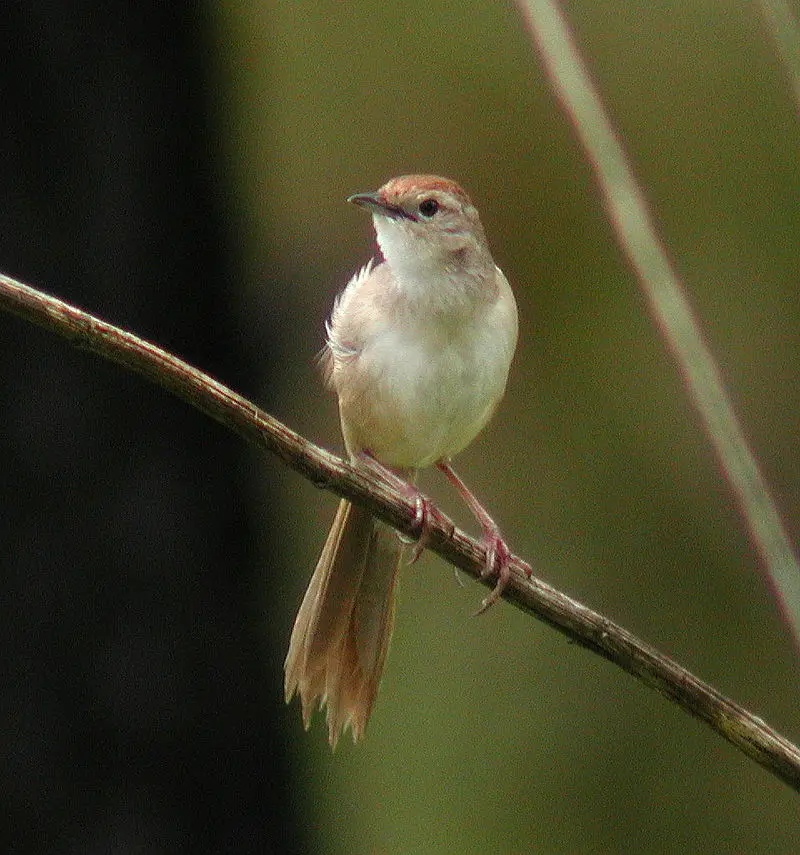
The tawny grassbird is a large songbird with an impressive brown cap and streaked upperparts. This bird belongs to the family of Locustellidae which live in grassland or reedbed habitats.
Its under parts are paler, while it has a long graduated tail. It also makes loud grumpy churring calls and longer ticking call that starts tick-tick-tick-tic.
They prefer open areas like wet meadows, marshlands or wetlands for their habitat as they feed on small insects from these area such as spiders, ants and beetles among others.
Their diet consist mainly of insects but some may supplement them with vegetable matter too during winter months when insect availability is low .
The tawny grassbirds usually breed between August to October each year depending upon the weather conditions..Scientific classification:
| Kingdom | Animalia |
| Phylum | Chordata |
| Class | Aves |
| Order | Passeriformes |
| Family | Locustellidae |
| Genus | Cincloramphus |
| Species | C. timoriensis |
11. Bar-Bellied Cuckooshrike
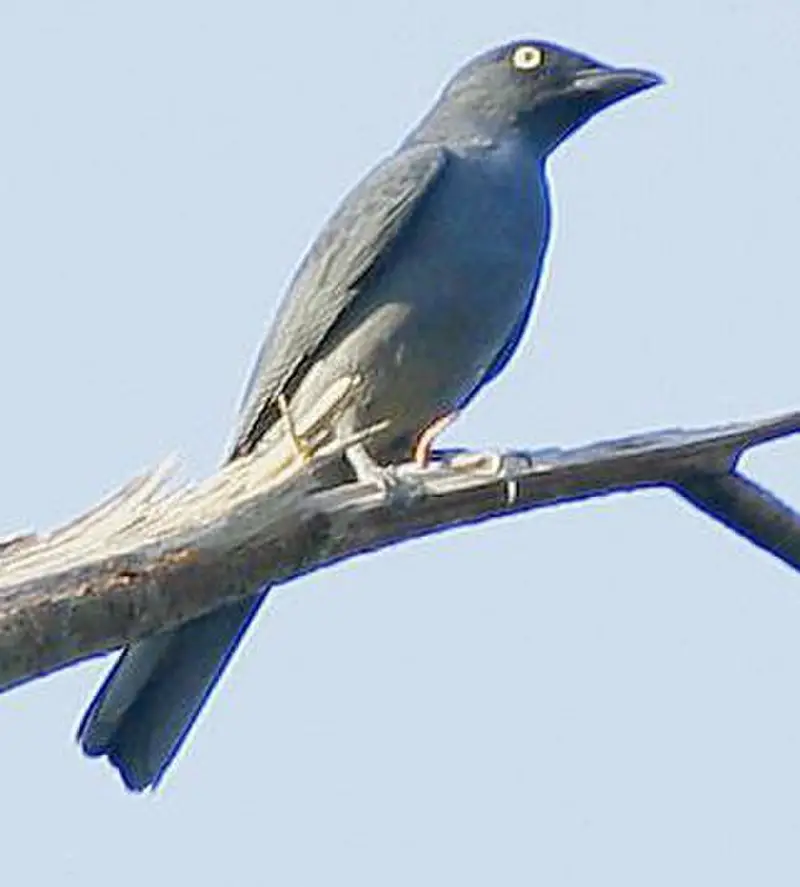
The Bar-bellied cuckooshrike is a species of bird belonging to the Campephagidae family. It can be found in Thailand, Malaysia, Indonesia and the Philippines inhabiting mangrove forests, dry forest, swamp forest and secondary growth areas.
Its plumage varies depending on its subspecies with different amounts of barring present on their underparts.
The International Union for Conservation of Nature (IUCN) has classified it as Least Concern due to its wide distribution range but there are still threats from habitat destruction that could affect populations over time.
This colourful bird makes an interesting addition to any enthusiast’s list.Scientific classification:
| Kingdom | Animalia |
| Phylum | Chordata |
| Class | Aves |
| Order | Passeriformes |
| Family | Campephagidae |
| Genus | Coracina |
| Species | C. striata |
Also Featured In: Brunei Darussalam Birds,
12. Indigo-Banded Kingfisher
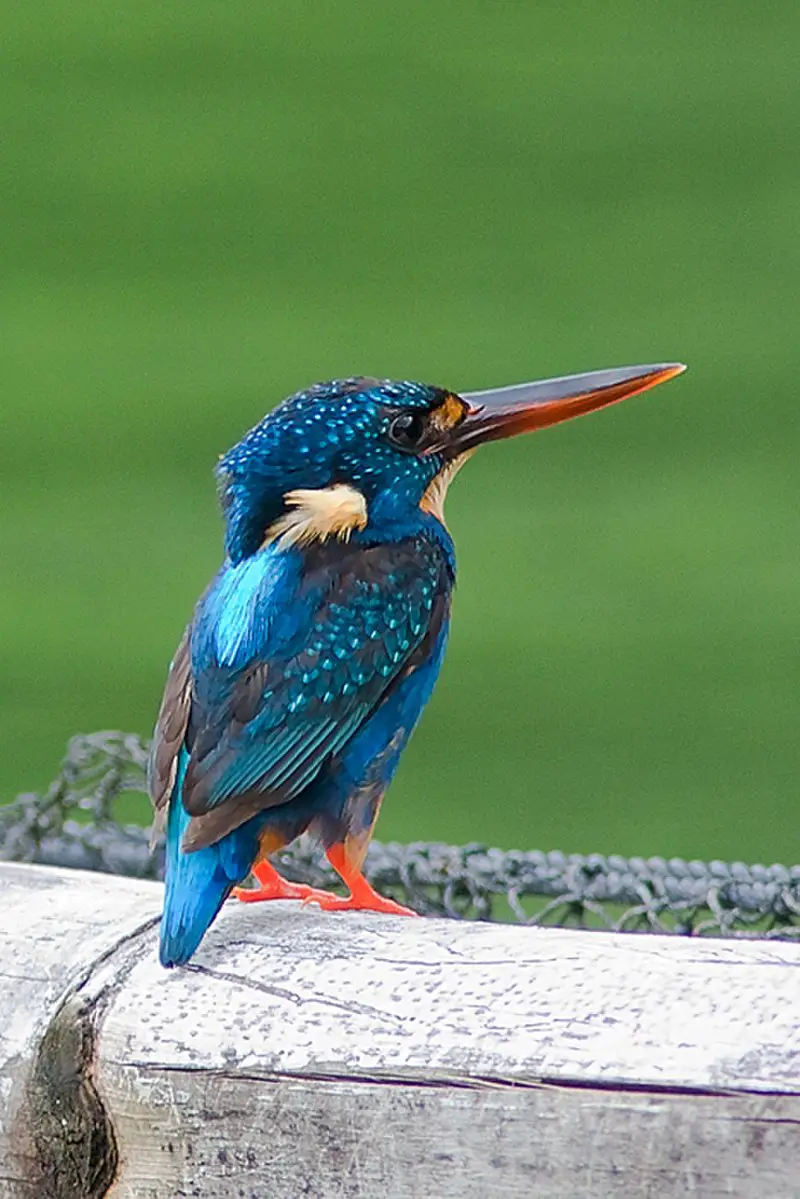
The Indigo-banded kingfisher is a species of bird belonging to the Alcedinidae family, found only in the Philippines. It has two subspecies – C. c. cyanopectus and C.
c nigriostris – which are generally uncommon but locally widespread across northern and central islands such as Luzon, Polillo, Mindoro, Sibuyan and Ticao; Panay; Negros respectively.
This vibrant yet small bird has striking plumage – predominantly blue with white patches on its wings along with an iridescent purple lower back that extends up to its head forming a crown like appearance giving it an air of regalness.
In terms of behavior they tend to be solitary birds preying mainly upon insects or small fish near rivers or ponds while perching atop branches close by allowing them ample opportunities for their characteristic dive bombing technique when hunting prey.Scientific classification:
| Kingdom | Animalia |
| Phylum | Chordata |
| Class | Aves |
| Order | Coraciiformes |
| Family | Alcedinidae |
| Subfamily | Alcedininae |
| Genus | Ceyx |
| Species | C. cyanopectus |
Also Featured In: Kingfishers Species, Common Philippines Birds
13. Philippine Cuckoo-Dove
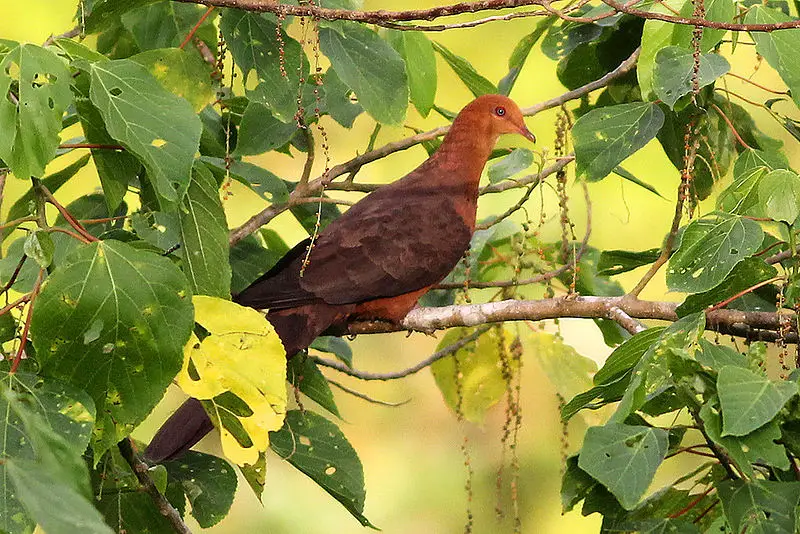
The Philippine cuckoo-dove is a species of bird found in the Philippines and Taiwan. It was first described by French zoologist Charles Lucien Jules Laurent Bonaparte in 1854, and is currently listed as a least concern species on the International Union for Conservation of Nature Red List of Endangered Species.
This dove typically has brownish grey plumage with white spots, long tail feathers, and black eyespots on its wings which it uses to startle predators away from nests or young birds.
Its diet consists mainly of fruits such as figs and berries along with some insects that are caught while perched low down amongst trees or bushes.
The Philippine cuckoo-dove tends to form pairs during breeding season but otherwise lives alone or within small groups outside this period.Scientific classification:
| Kingdom | Animalia |
| Phylum | Chordata |
| Class | Aves |
| Order | Columbiformes |
| Family | Columbidae |
| Genus | Macropygia |
| Species | M. tenuirostris |
Also Featured In: Pigeons Species, Most Common Birds in Negros
14. Philippine Swiftlet
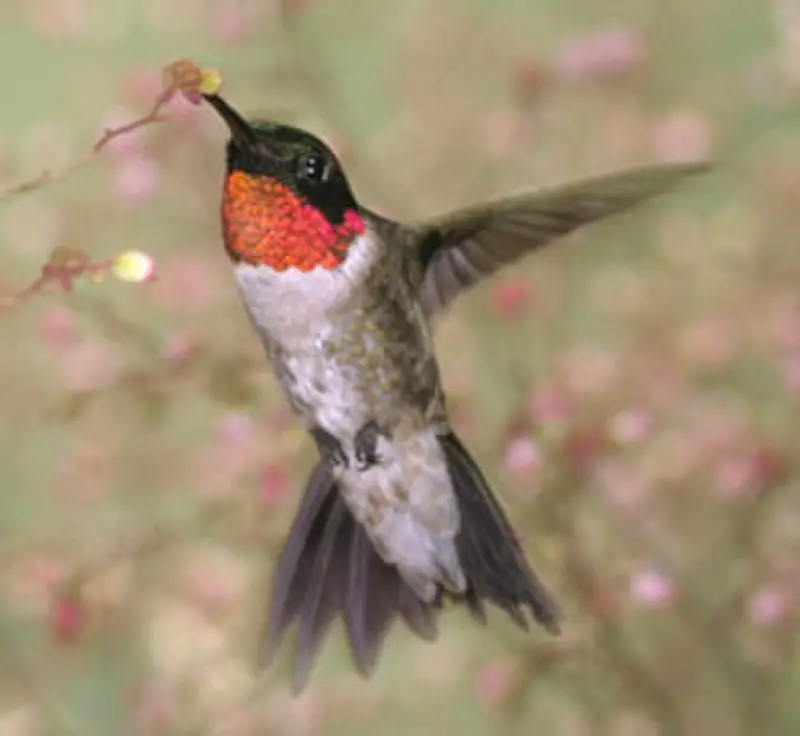
The Philippine swiftlet is a species of bird belonging to the Apodidae family found only in the Philippines. It inhabits dry and moist lowland forests as well as montane forests, making it quite adaptable.
The coloration of this small-medium sized bird ranges from greyish brown to black with white markings on its wings and tail feathers.
Its diet consists mainly of insects which are caught while flying through the air or picked up off trees or branches.
This species has been classified by IUCN Red List as least concern due to its wide distribution range across multiple islands within the country, although some local populations may be at risk if deforestation continues unchecked in their habitats.Scientific classification:
| Kingdom | Animalia |
| Phylum | Chordata |
| Class | Aves |
| Order | Apodiformes |
| Family | Apodidae |
| Genus | Aerodramus |
| Species | A. mearnsi |
Also Featured In: Swifts Species, Palawan Island Birds
15. Elegant Tit
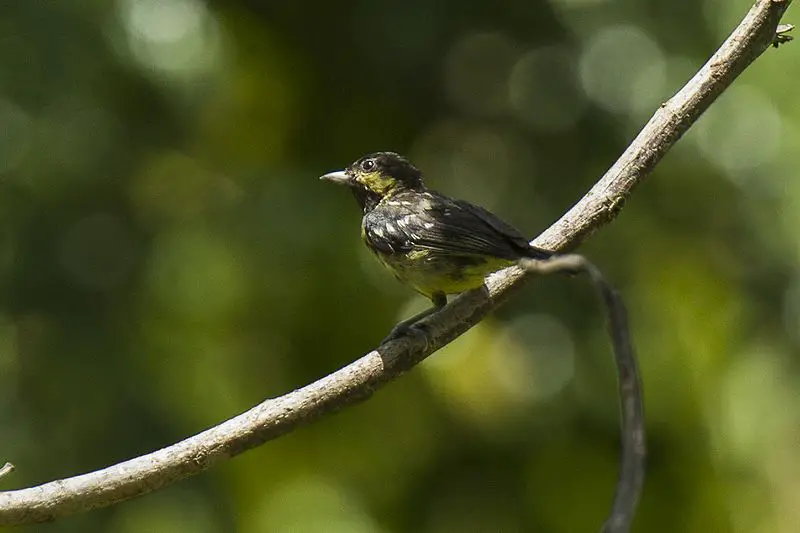
The Elegant tit bird is a beautiful species of tit that is found exclusively in the Philippines. Formerly classified under the Parus genus, it was subsequently reclassified under Pardaliparus along with the yellow-bellied tit and Palawan tit.
This change was based on the findings of a molecular study in 2013 that led to the resurrection of several genera.
The Elegant tit is known for its elegant features and is highly sought after by bird enthusiasts. This bird is a testament to the rich wildlife found in the Philippines and is a welcomed addition to the avian kingdom.
Overall, the Elegant tit bird is a unique and beautiful species that deserves admiration and protection.Scientific classification:
| Kingdom | Animalia |
| Phylum | Chordata |
| Class | Aves |
| Order | Passeriformes |
| Family | Paridae |
| Genus | Pardaliparus |
| Species | P. elegans |
Also Featured In: Mindanao Birds You Should Know,
16. Whiskered Treeswift
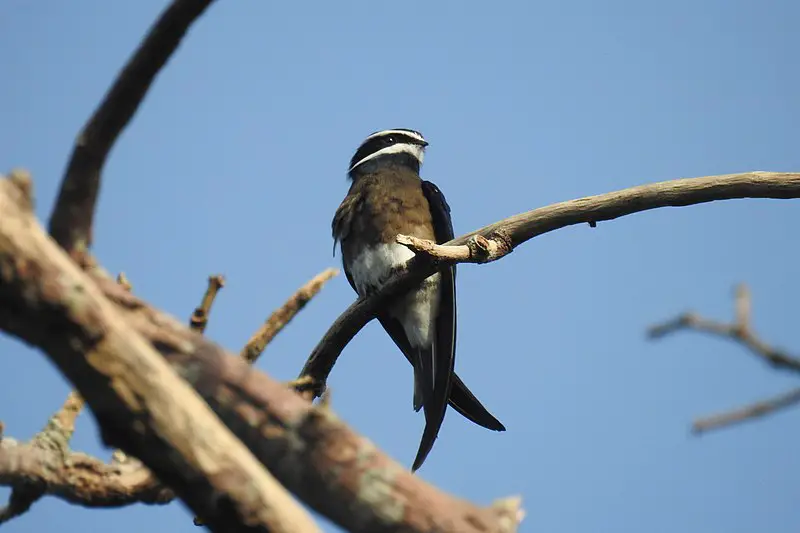
The Whiskered treeswift is a small bird belonging to the Hemiprocnidae family. It is one of the four species in the Hemiprocne genus, and it can be found in Brunei, Indonesia, Malaysia, Myanmar, the Philippines, Singapore, and Thailand.
This species inhabits subtropical or tropical moist lowland forest, mangrove forest, and moist montane forests.
The bird’s whiskers give it an interesting look, hence its name. Though small, the Whiskered treeswift is an adept aerial hunter, darting through the trees in search of insects.
Its small size also allows it to fly quickly and maneuver easily in tight spaces. This bird is considered to be of least concern when it comes to conservation status, as its population is thought to be stable.Scientific classification:
| Kingdom | Animalia |
| Phylum | Chordata |
| Class | Aves |
| Clade | Strisores |
| Order | Apodiformes |
| Family | Hemiprocnidae |
| Genus | Hemiprocne |
| Species | H. comata |
Also Featured In: Birds that Live in Borneo Island, Birds that Live in Kuala Lumpur
17. Mindoro Bleeding-Heart
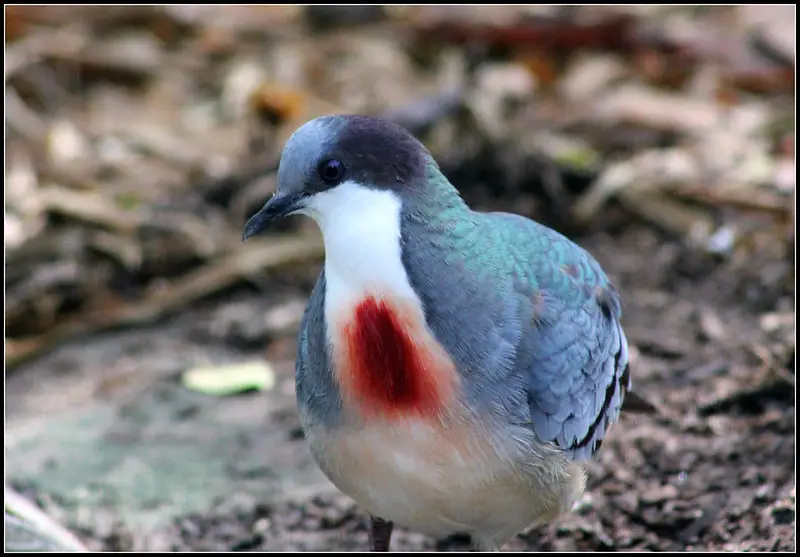
The Mindoro Bleeding-heart bird is a rare and critically endangered ground dove found exclusively on the island of Mindoro in the Philippines.
It is known by multiple names, including kulo-kulo, la-do, manatad, manuk-manuk, punay, and puñalada.
The Mangyan people have also given it various names. This bird is at risk of extinction due to habitat loss caused by marble extraction.
It is a vital part of the island’s ecosystem, and its survival is crucial. Because of its biological lineage and endangered status, it has attracted attention from conservationists and bird enthusiasts worldwide.
Efforts are being made to protect its habitat and prevent further decline in its population.
Despite these efforts, it remains crucial for individuals and organizations to help raise awareness about the Mindoro Bleeding-heart bird and support conservation efforts to protect it.Scientific classification:
| Kingdom | Animalia |
| Phylum | Chordata |
| Class | Aves |
| Order | Columbiformes |
| Family | Columbidae |
| Genus | Gallicolumba |
| Species | G. platenae |
18. Mindoro Imperial-Pigeon
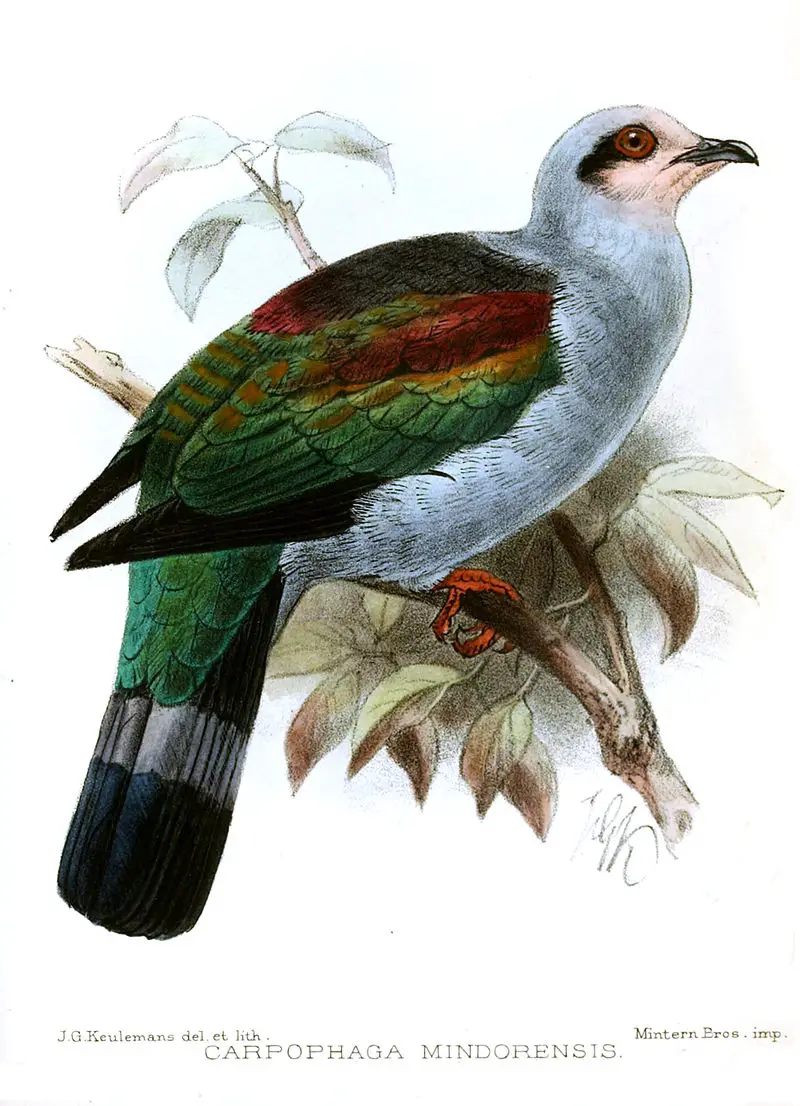
The Mindoro imperial pigeon, also known as the Pink-throated Imperial pigeon, is a bird species found in the mountains of Mindoro in the Philippines. It is the largest pigeon in the country, reaching up to 50cm in length.
It is classified as an Endangered species due to habitat loss and hunting. The bird belongs to the family Columbidae and is distinct with its pink throat and grey body. It is a valuable species that plays a crucial role in the ecological balance.
Conservation efforts are being made to protect the species and prevent it from further endangerment.Scientific classification:
| Kingdom | Animalia |
| Phylum | Chordata |
| Class | Aves |
| Order | Columbiformes |
| Family | Columbidae |
| Genus | Ducula |
| Species | D. mindorensis |
19. Black-Hooded Coucal
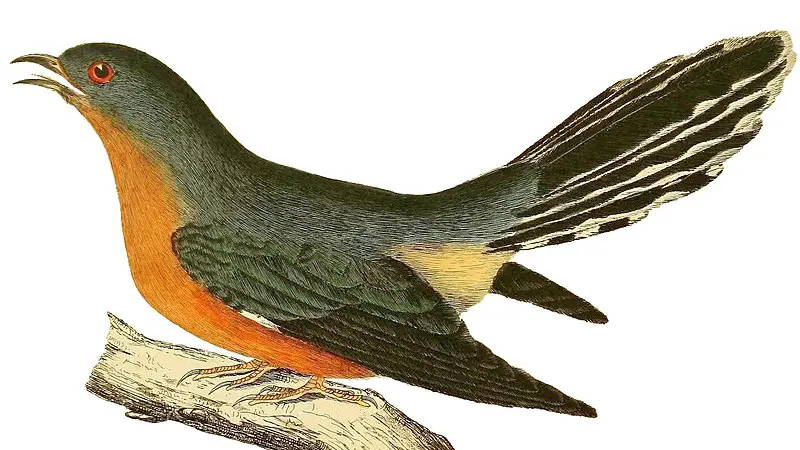
The Black-hooded Coucal is a species of cuckoo found exclusively on the island of Mindoro in the Philippines. This bird is in great danger of extinction due to habitat loss and trapping.
It is known for its large size, long tail, and distinctive black head. The body is mostly brown in color, with dark wings edged in brown feathers.
The Black-hooded Coucal can be found in lowland primary forests on the island, where it feeds on insects, larvae, and small reptiles.
Despite being one of the most endangered birds in the Philippines, conservation efforts are underway to protect this unique species and its habitat for future generations to enjoy.Scientific classification:
| Kingdom | Animalia |
| Phylum | Chordata |
| Class | Aves |
| Order | Cuculiformes |
| Family | Cuculidae |
| Genus | Centropus |
| Species | C. steerii |
20. Mindoro Hornbill
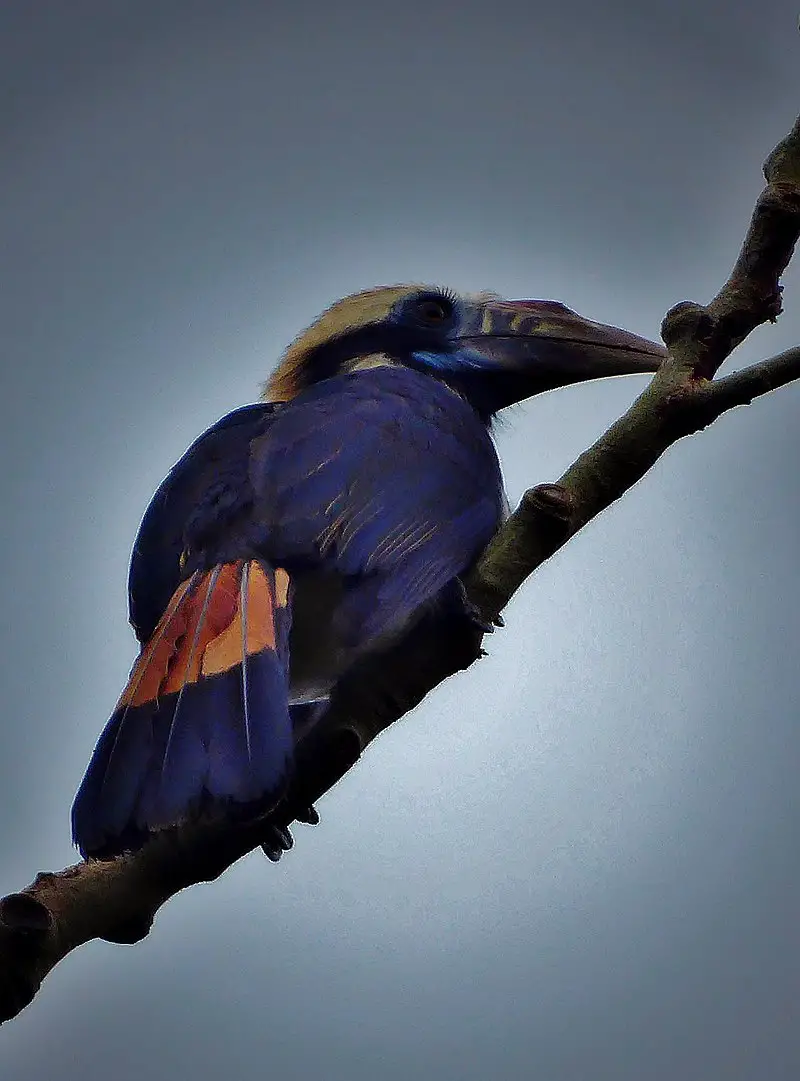
The Mindoro hornbill is a bird species that belongs to the Bucerotidae family. It can only be found in Mindoro, an island in the Philippines. It inhabits the tropical moist lowland forests of the region.
This bird was previously classified as a subspecies of P. panini, a Philippine tarictic hornbill. In this bird species, both sexes have cream-white and black feathers.
The bird’s appearance is striking due to the creamy-white and black coloration of their feathers, which is unique to this tarictic hornbill species.
The Mindoro hornbill is among the endangered bird species in the Philippines, with populations declining due to habitat loss and hunting.
Conservation efforts are essential to maintain and protect this unique and beautiful bird species.Scientific classification:
| Kingdom | Animalia |
| Phylum | Chordata |
| Class | Aves |
| Order | Bucerotiformes |
| Family | Bucerotidae |
| Genus | Penelopides |
| Species | P. mindorensis |
21. Turquoise Flycatcher
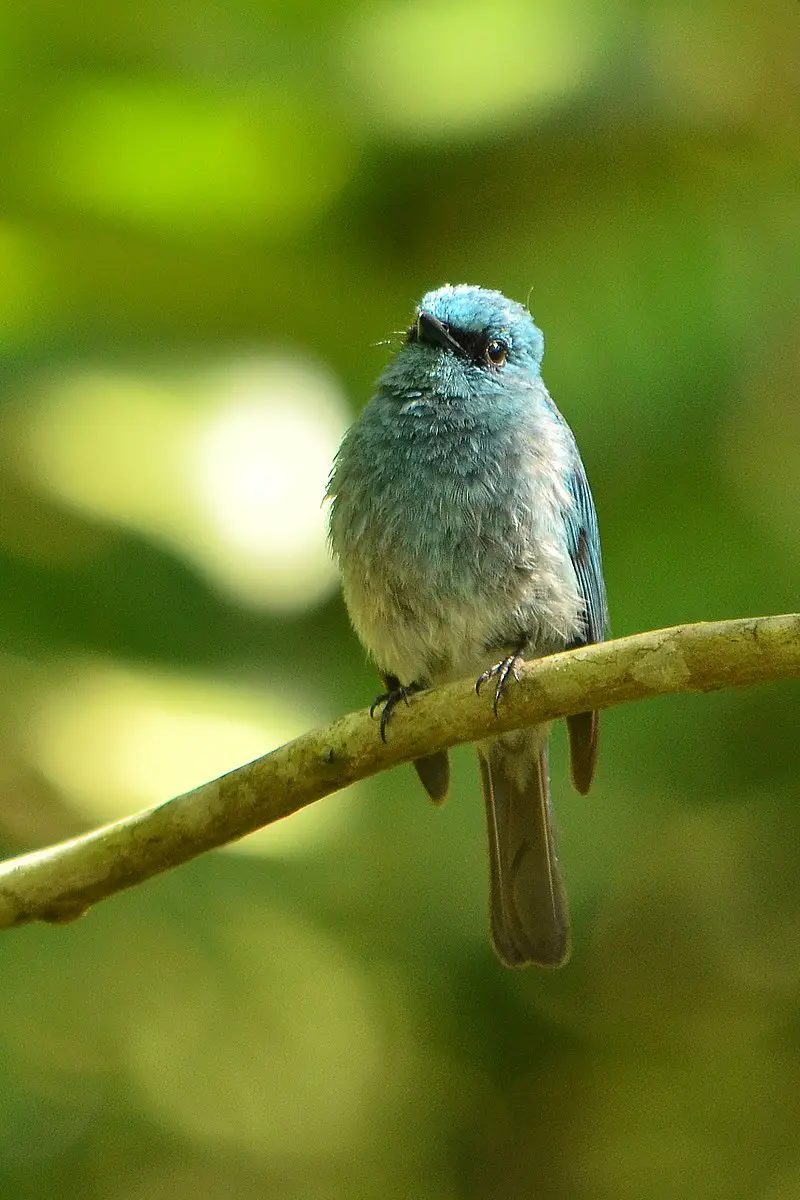
The turquoise flycatcher bird is a member of the Muscicapidae family. It can be found in the lush, subtropical forests of Indonesia and the Philippines.
Aptly named for its beautiful turquoise color, this small bird is also known as the island flycatcher. It thrives in moist, montane forests and flits through the trees in search of insects for food.
Despite its small size, it has a loud and clear whistle-like call that echoes through the forest. This stunning bird is a testament to the beauty and diversity of the natural world.Scientific classification:
| Kingdom | Animalia |
| Phylum | Chordata |
| Class | Aves |
| Order | Passeriformes |
| Family | Muscicapidae |
| Genus | Eumyias |
| Species | E. panayensis |
Also Featured In: Birds that Live Near Halmahera,
22. Pink-Bellied Imperial Pigeon
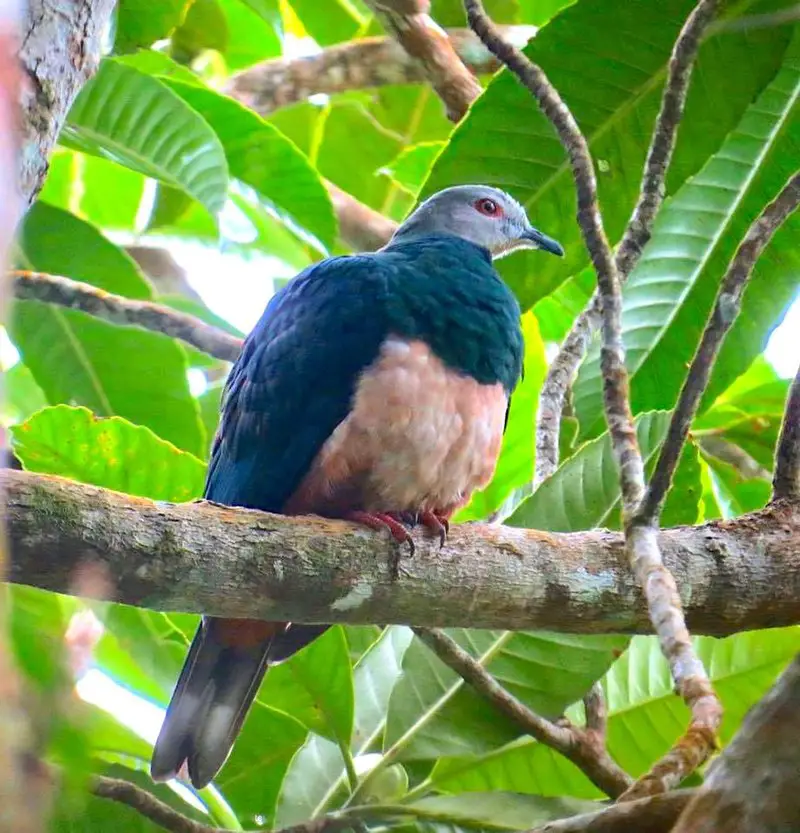
The Pink-bellied imperial pigeon, also called the zone-tailed pigeon, is a large bird found in the Philippines that can grow up to 42cm long. They are mostly dark green in color, with a gray head and a pink belly.
Their tail has a brown, black, and gray pattern, and their eyes and eye ceres are both red. The Pink-bellied imperial pigeon has a diet consisting mostly of fruit.
These birds are known for their stunning appearance and large size, making them an impressive sight in the wild.
They are a unique addition to the bird species of the Philippines, and their distinctive features make them stand out amongst other birds in the area.
Despite their size, Pink-bellied imperial pigeons are peaceful birds and pose no threat to humans or other animals.Scientific classification:
| Kingdom | Animalia |
| Phylum | Chordata |
| Class | Aves |
| Order | Columbiformes |
| Family | Columbidae |
| Genus | Ducula |
| Species | D. poliocephala |
Also Featured In: Samar Island Birds You Should Know,
23. Purple-Throated Sunbird
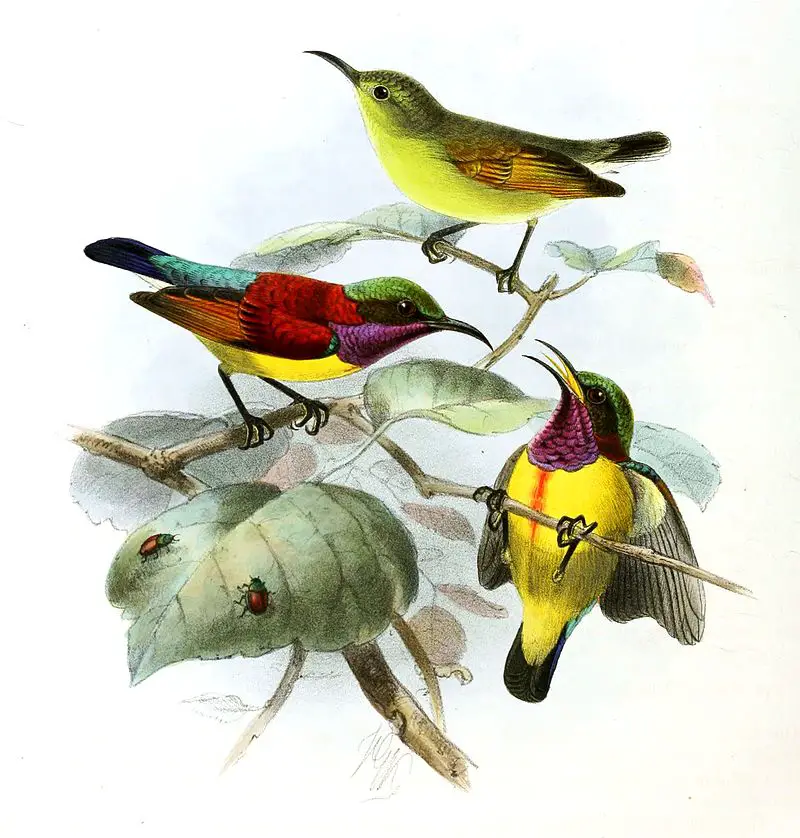
The purple-throated sunbird is a bird species that belongs to the Nectariniidae family. It can be found in lowland tropical forests and subtropical or tropical mangrove forests of Maratua and the Philippines.
This small bird has a purple-colored throat that distinguishes it from other sunbirds. It was first described by French zoologist Mathurin Jacques Brisson in 1760.
The Van Hasselt’s sunbird used to be considered the same species as the purple-throated sunbird, but they are now recognized as distinct species.
These birds feed mainly on nectar, and they play an essential role in pollination. The purple-throated sunbird is a fascinating bird that attracts attention with its brightly colored throat and its important ecological role.Scientific classification:
| Kingdom | Animalia |
| Phylum | Chordata |
| Class | Aves |
| Order | Passeriformes |
| Family | Nectariniidae |
| Genus | Leptocoma |
| Species | L. sperata |
24. Philippine Nightjar
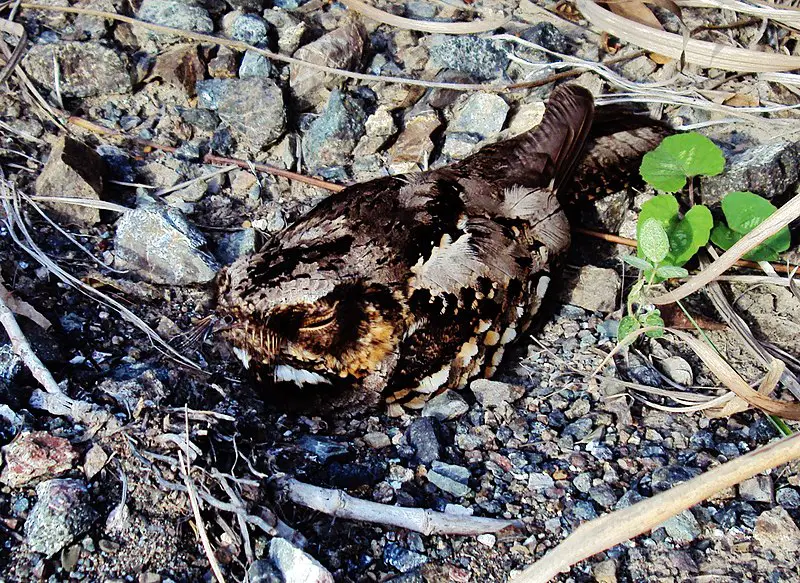
The Philippine Nightjar is a unique species of bird that can only be found in the Philippines. It is locally known as kandarapa and tagolilong.
This bird belongs to the Caprimulgidae family and commonly resides in subtropical or tropical forests with moist lowlands or mangroves.
Occasionally, it can also dwell in the subtropical or tropical forests in mountainous areas. The Philippine Nightjar is a nocturnal bird and is active only during nighttime.
They are small, with over-sized heads and wide beaks, perfectly crafted for catching insects in the air.
Though they are widely distributed throughout the country, they are elusive and incredibly difficult to spot, making them quite rare to witness.
Despite their rarity, the Philippine Nightjar continues to thrive in its natural habitat, making for a lovely sight to see for those who are fortunate enough to see them.Scientific classification:
| Kingdom | Animalia |
| Phylum | Chordata |
| Class | Aves |
| Clade | Strisores |
| Order | Caprimulgiformes |
| Family | Caprimulgidae |
| Genus | Caprimulgus |
| Species | C. manillensis |
25. Handsome Sunbird
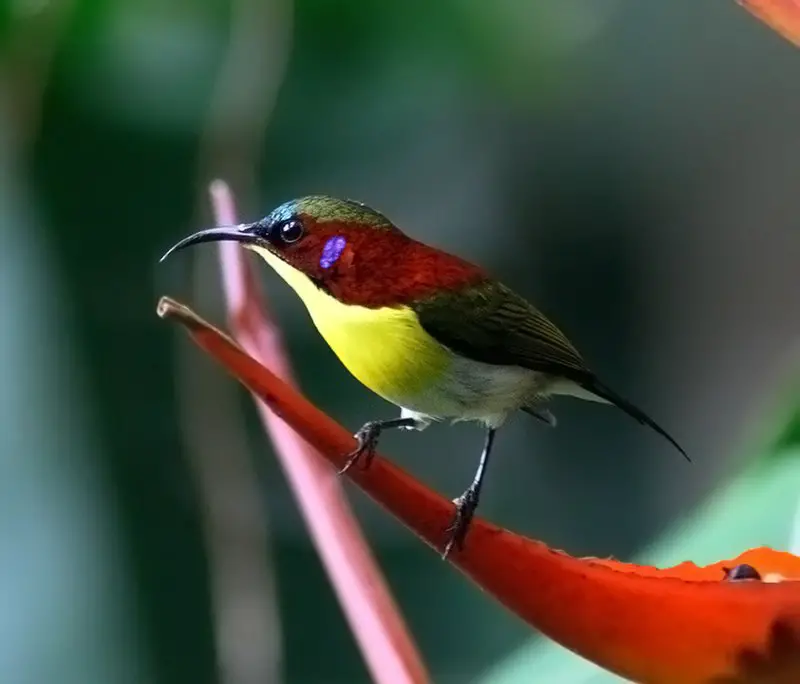
The Handsome sunbird, found exclusively in the Philippines, is a member of the Nectariniidae family. This species is known for its vibrant and striking colors, making it a visually stunning bird.
They are typically found in subtropical or tropical moist lowland forests and montane forests. Due to their affinity for nectar, they play an important role in pollination.
This bird species is known for its agility in flight and its elongated bill, perfectly designed for extracting nectar from flowers.
The Handsome sunbird is an important part of the ecosystem in which it resides, contributing to both biological diversity and the maintenance of plant life.
Its beauty can only be truly appreciated by those who have had the privilege of seeing it in person.Scientific classification:
| Kingdom | Animalia |
| Phylum | Chordata |
| Class | Aves |
| Order | Passeriformes |
| Family | Nectariniidae |
| Genus | Aethopyga |
| Species | A. bella |
26. Philippine Pitta
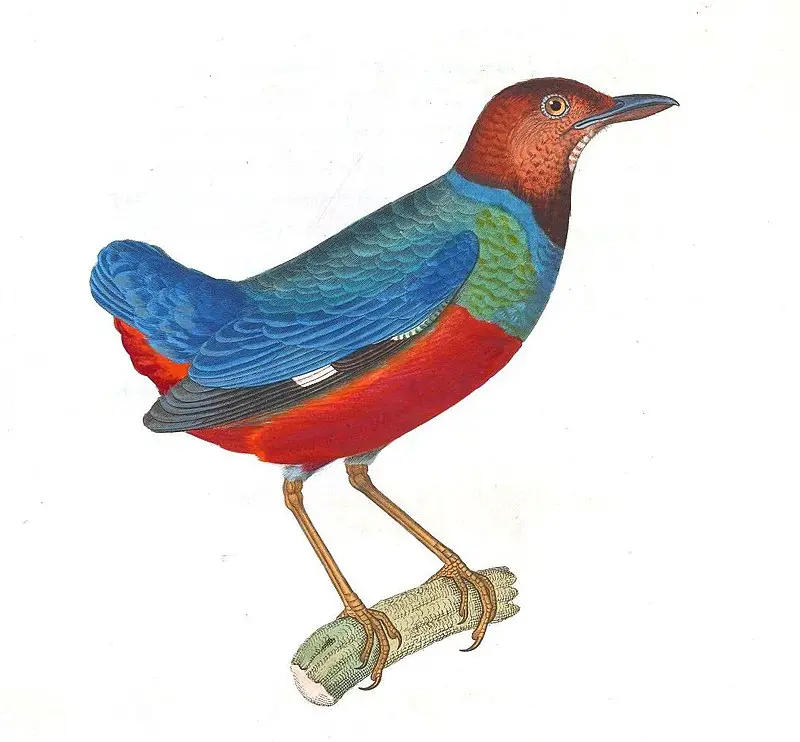
The Philippine pitta, also known as the blue-breasted pitta, is a bird found in the Philippines and Indonesia. With a pointed beak and a red belly, it has a distinct green-blue band above it.
The bird can be spotted in subtropical or tropical moist lowland forests, where it thrives in its natural habitat. This species was previously considered a subspecies of the red-bellied pitta, but was later recognized as a distinct species.
The Philippine pitta is a small bird with a wingspan that allows it to fly swiftly through dense forest foliage. It has a colorful plumage and adds to the natural beauty of the forests it inhabits.
Despite its beauty, this species faces threats to its habitat from deforestation and habitat fragmentation, which affect its population in the wild.Scientific classification:
| Kingdom | Animalia |
| Phylum | Chordata |
| Class | Aves |
| Order | Passeriformes |
| Family | Pittidae |
| Genus | Erythropitta |
| Species | E. erythrogaster |
27. Balicassiao
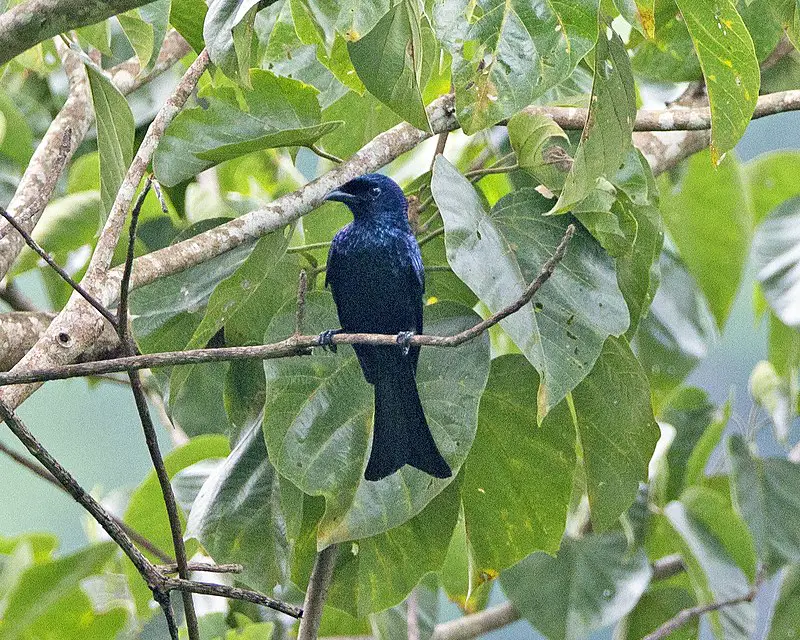
The Balicassiao bird is a notable passerine species endemic to the Philippines. These medium-sized birds have subtle physical differences depending on their race, with abraensis being the largest and either completely black or having a white lower breast and belly in mirabilis.
Balicassiaos can be found in subtropical or tropical moist lowland forests, and are well adapted to these environments.
Despite not being particularly visually striking or well-known, these birds play an important role in their ecosystem as they help to control the insect population.
Moreover, the Balicassiao bird has long been a subject of interest for zoologists, with French researchers first describing the species in 1760.Scientific classification:
| Kingdom | Animalia |
| Phylum | Chordata |
| Class | Aves |
| Order | Passeriformes |
| Family | Dicruridae |
| Genus | Dicrurus |
| Species | D. balicassius |
28. Philippine Coucal
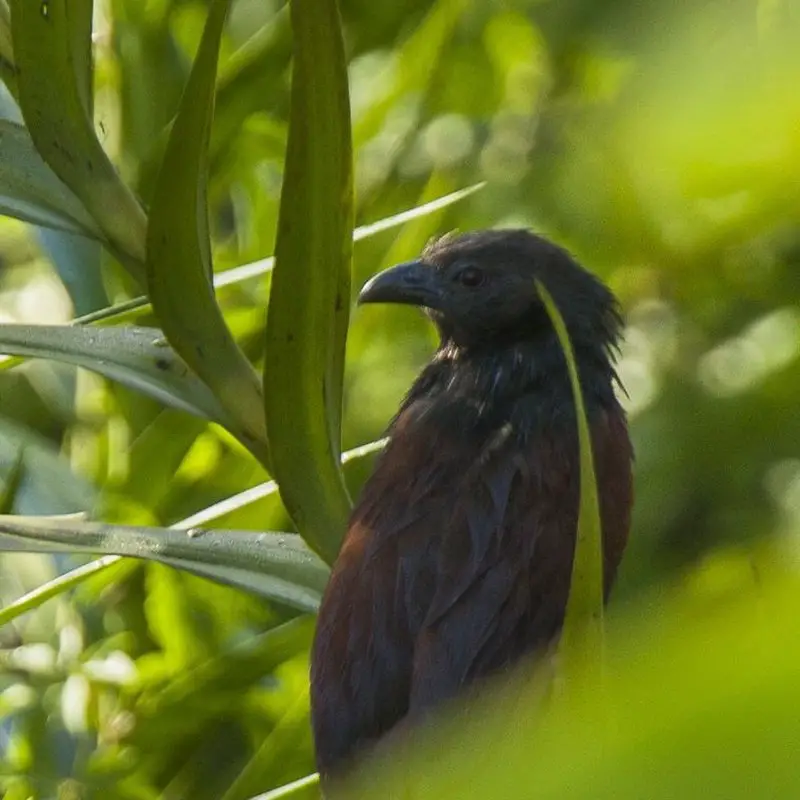
The Philippine coucal bird is a type of cuckoo found exclusively in the Philippines. This medium-sized bird has similar physical characteristics for both males and females, while different races of this species vary in color and size.
Some races, such as the carpenteri and mindorensis, appear completely black, while others like the viridis and majer display a black body with chestnut-colored wings. The carpenteri and majer variants are larger than viridis and mindorensis.
The viridis type possesses an overall black appearance, accented with a green sheen. As an endemic species, the Philippine coucal is only found in the Philippines, making it an important part of the country’s biodiversity.
Despite being a relatively lesser-known species compared to other birds, the Philippine coucal proves to be an interesting representative of avian life in the country.Scientific classification:
| Kingdom | Animalia |
| Phylum | Chordata |
| Class | Aves |
| Order | Cuculiformes |
| Family | Cuculidae |
| Genus | Centropus |
| Species | C. viridis |
Also Featured In: Most Common Catanduanes Birds,
29. White-Bellied Munia
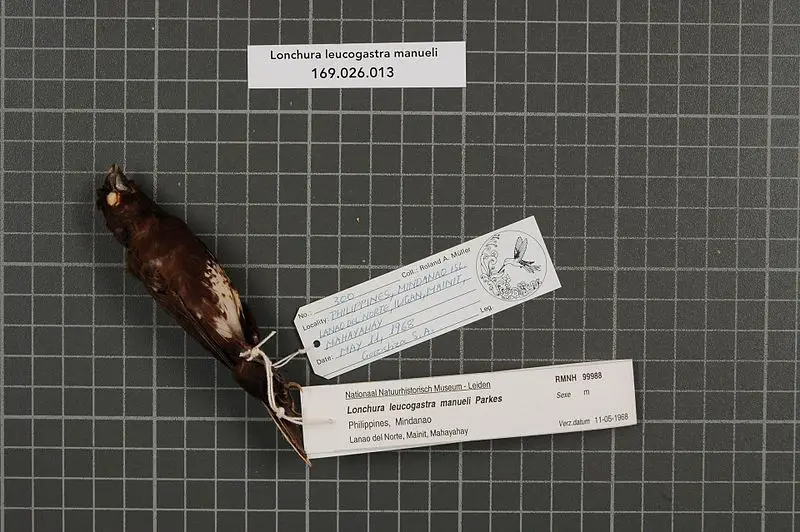
The White-bellied Munia is a finch species that can be found in the Malesia region. It is known for its white belly which gives it its name. This bird’s natural habitat is in subtropical and tropical lowland moist forests.
Despite habitat loss and degradation, the species is currently evaluated as Least Concern.
The White-bellied Munia’s diet consists of seeds and insects, and they are known to live in flocks. They are active during the day and communicate with soft chirps and calls.
The male and female have similar appearance, with a brown body and a white belly, but the male is slightly larger. While they are not commonly kept as pets, some people enjoy watching them in aviaries.
Overall, the White-bellied Munia is a unique and interesting bird species found in lush, forested habitats.Scientific classification:
| Kingdom | Animalia |
| Phylum | Chordata |
| Class | Aves |
| Order | Passeriformes |
| Family | Estrildidae |
| Genus | Lonchura |
| Species | L. leucogastra |
30. Bicolored Flowerpecker
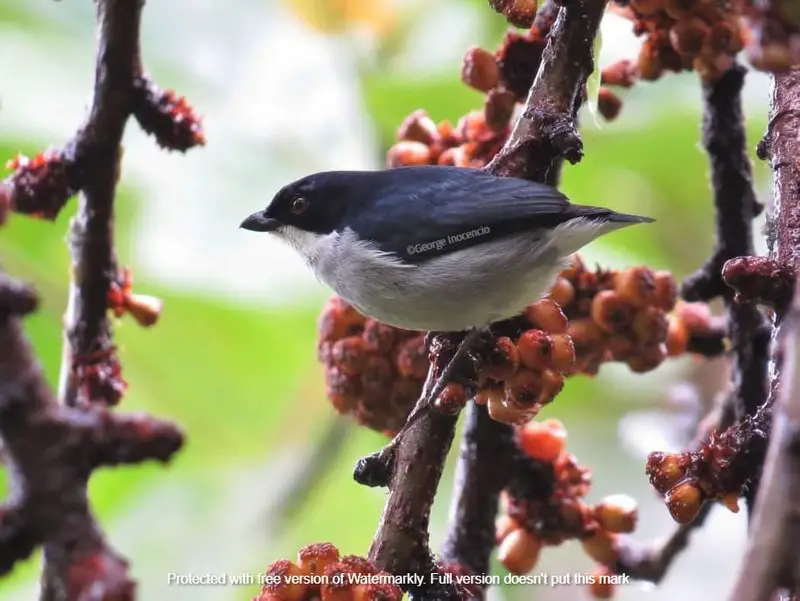
The Bicolored flowerpecker is a tiny bird that is native to the Philippines. They can be found in tropical forests and sometimes venture up to 2,250 meters above sea level.
They often roam in mixed flocks of other small birds, such as white-eyes and sunbirds. This species is known for their vibrant two-tone feathers and their unique beak shape, which is perfect for eating nectar and fruits.
Despite their small size, they are energetic creatures that flit around the trees and bushes looking for snacks. The Bicolored flowerpecker plays a vital role in their ecosystem by helping to pollinate flowers and disperse seeds.
It is a pleasure to catch a glimpse of these stunningly colorful birds when exploring the forests of the Philippines.Scientific classification:
| Kingdom | Animalia |
| Phylum | Chordata |
| Class | Aves |
| Order | Passeriformes |
| Family | Dicaeidae |
| Genus | Dicaeum |
| Species | D. bicolor |
31. Pygmy Flowerpecker
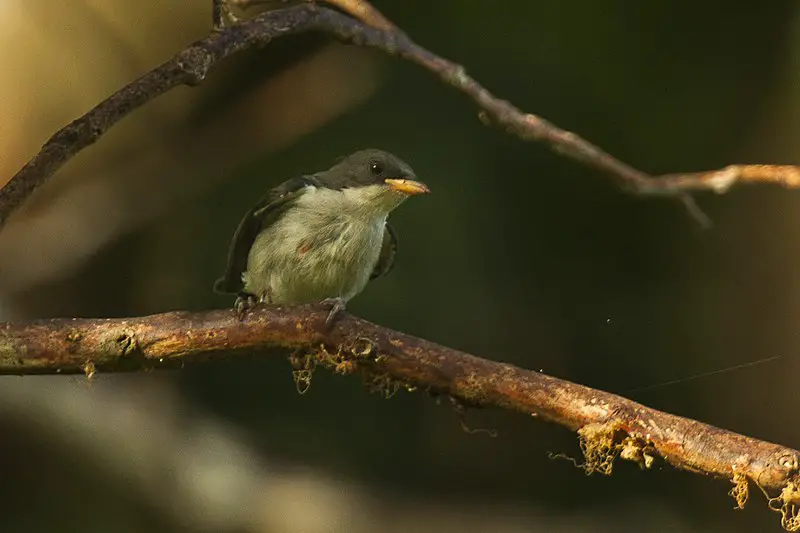
The tiny Pygmy flowerpecker is a unique bird species found only in the Philippines. They prefer to inhabit moist forests, both lowland and montane. With their size, they are easily overlooked as they blend in with the surrounding foliage.
These little birds have a distinctive black cap and upperparts that contrast against their striking red underparts.
They are known to feed on nectar and small insects. Despite their small size, they have a loud and sharp voice that can be heard during their courtship displays.
Unfortunately, the Pygmy flowerpecker faces threats from habitat loss due to deforestation, which makes preserving their habitats crucial for their survival.
Overall, these little birds are a valuable species in the Philippines, adding to the biodiversity of the country’s rich ecosystem.Scientific classification:
| Kingdom | Animalia |
| Phylum | Chordata |
| Class | Aves |
| Order | Passeriformes |
| Family | Dicaeidae |
| Genus | Dicaeum |
| Species | D. pygmaeum |
32. Little Pied Flycatcher
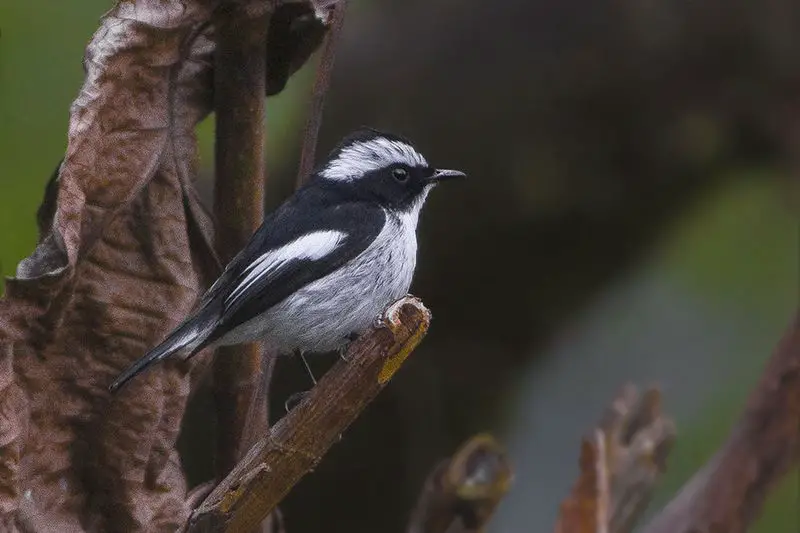
The Little Pied Flycatcher is a bird that belongs to the family Muscicapidae. This species can be found in several countries in Southeast Asia and the Indian Subcontinent.
Its natural habitats include subtropical or tropical moist lowland forests and moist moors. This bird is relatively small in size and has distinct black and white markings on its body.
It feeds primarily on insects and can often be seen quickly darting through the air to catch its prey. Despite its small size, this bird is known for its beautiful singing voice, which can often be heard echoing through its natural habitats.
Overall, the Little Pied Flycatcher is a charming bird species that adds to the biodiversity found in its range of habitat.Scientific classification:
| Kingdom | Animalia |
| Phylum | Chordata |
| Class | Aves |
| Order | Passeriformes |
| Family | Muscicapidae |
| Genus | Ficedula |
| Species | F. westermanni |
33. Yellowish White-Eye
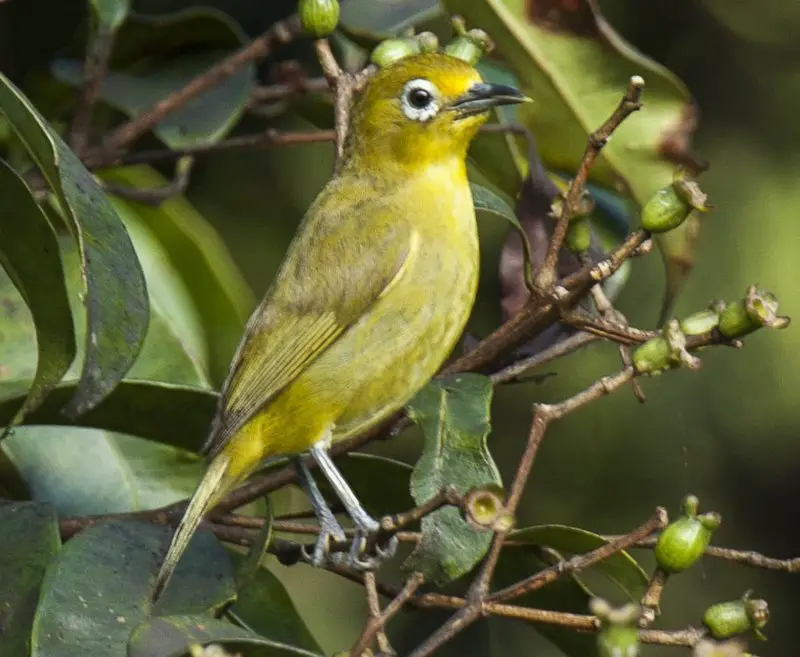
The Yellowish white-eye is a bird that can be found exclusively in the Philippines. This species belongs to the Zosteropidae family and is also known as the golden-yellow white-eye.
Their natural habitat is tropical forests with a moist, lowland environment. With their striking yellow feathers and small size, these birds are a fascinating sight to behold. They are highly adaptable and have been known to feed on insects and fruits.
The Yellowish white-eye has a unique song that is often used for communication among other members of their flock. Though they are not considered to be threatened, deforestation and habitat loss pose a threat to their survival.
These delicate and fascinating birds continue to draw attention and garner interest from bird enthusiasts around the world.Scientific classification:
| Kingdom | Animalia |
| Phylum | Chordata |
| Class | Aves |
| Order | Passeriformes |
| Family | Zosteropidae |
| Genus | Zosterops |
| Species | Z. nigrorum |
34. Scarlet-Collared Flowerpecker
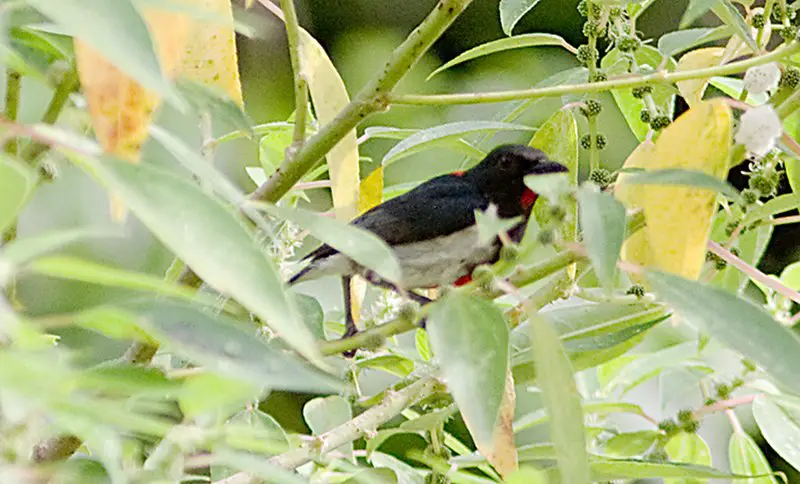
The Scarlet-collared flowerpecker is a bird species that is exclusive to the Philippines. It measures around 10 cm and has a distinct scarlet-colored collar.
Endemic only to Mindoro, this tiny bird can be found in the canopy of the forest, as well as in open areas with scattered trees. Its unique call sounds like striking two stones together and a high-pitched ‘zeet zeet zeet’.
This bird species has garnered attention due to its brightly colored plumage and distinctive call. The Scarlet-collared flowerpecker’s diet mainly consists of nectar, fruits, and insects.
Overall, this bird is an important part of the ecosystem in the Philippines as it helps in pollination and pest control.Scientific classification:
| Kingdom | Animalia |
| Phylum | Chordata |
| Class | Aves |
| Order | Passeriformes |
| Family | Dicaeidae |
| Genus | Dicaeum |
| Species | D. retrocinctum |
35. Ashy Thrush
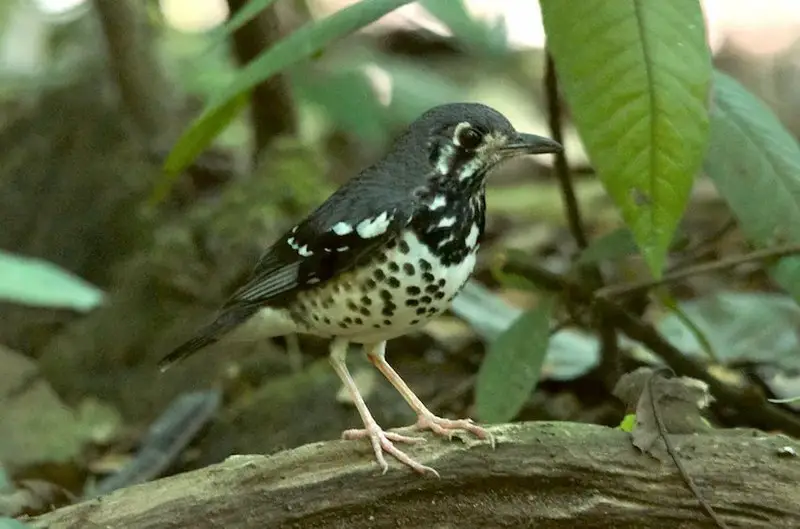
The ashy thrush, a member of the Turdidae family, is a medium-sized bird found only in the Philippines on the islands of Luzon and Mindoro. This ground-thrush species is well adapted to tropical moist lowland forests and moist montane forests.
Sadly, habitat loss and illegal wildlife trade are threats to its survival. The ashy thrush is characterized by its beautiful ashy-grey plumage and is a sight to behold in its natural habitat. Its melodious voice fills the forest and is a joy to hear.
This stunning bird is a precious part of the ecosystem and deserves our protection.Scientific classification:
| Kingdom | Animalia |
| Phylum | Chordata |
| Class | Aves |
| Order | Passeriformes |
| Family | Turdidae |
| Genus | Geokichla |
| Species | G. cinerea |
36. Mindoro Boobook
The Mindoro boobook, also known as the Mindoro hawk-owl, is a small owl species that can be found exclusively in the Philippines.
It prefers to inhabit lowland and foothill forest areas, showcasing a dark brown color on the head and back, and reddish-brown on the chest.
Its striking features include bright yellow eyes and thin white eyebrows that form a distinctive V-shape. Often, it gets confused with the similar-looking Mindoro scops-owl.
With their unique appearance and habitat, Mindoro boobooks play a crucial role in maintaining the ecosystem balance in the Philippines.
These birds can be appreciated for their beauty and rarity, making them an important part of the country’s biodiversity.Scientific classification:
| Kingdom | Animalia |
| Phylum | Chordata |
| Class | Aves |
| Order | Strigiformes |
| Family | Strigidae |
| Genus | Ninox |
| Species | N. mindorensis |
37. Green-Backed Whistler
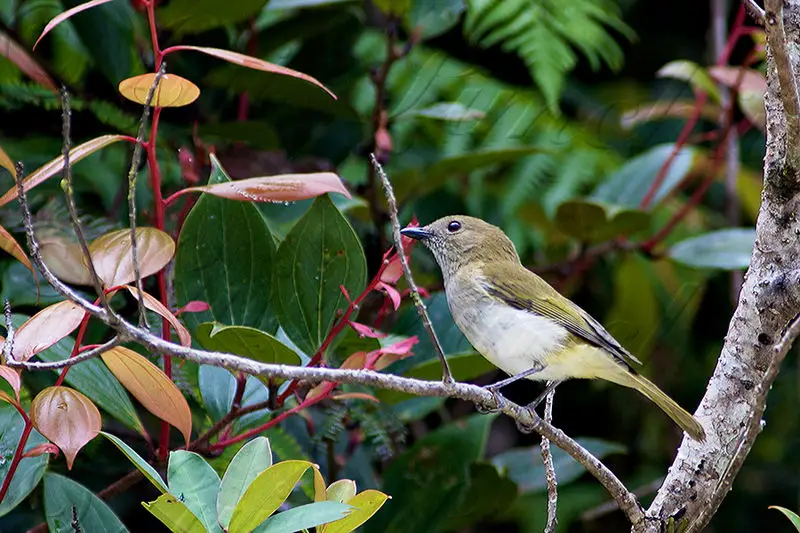
The Green-backed whistler bird, also known as the Olive-backed whistler, is a species belonging to the Pachycephalidae family. Endemic to the Philippines, it is commonly found in tropical moist lowland and montane forests.
This bird species stands out due to its green-colored back and white underparts. While some experts initially believed it to be a subspecies of the mangrove whistler, it is now recognized as a distinct species with three recognized subspecies.
The Green-backed whistler has a distinct whistling sound, hence the name, and is known to be a skilled singer. This bird species plays a crucial role in pollination and the dissemination of plants’ seeds in their habitat.
The Green-backed whistler represents an important component of the Philippines’ unique biodiversity, making it an essential focus for conservation efforts.Scientific classification:
| Kingdom | Animalia |
| Phylum | Chordata |
| Class | Aves |
| Order | Passeriformes |
| Family | Pachycephalidae |
| Genus | Pachycephala |
| Species | P. albiventris |
38. Lowland White-Eye
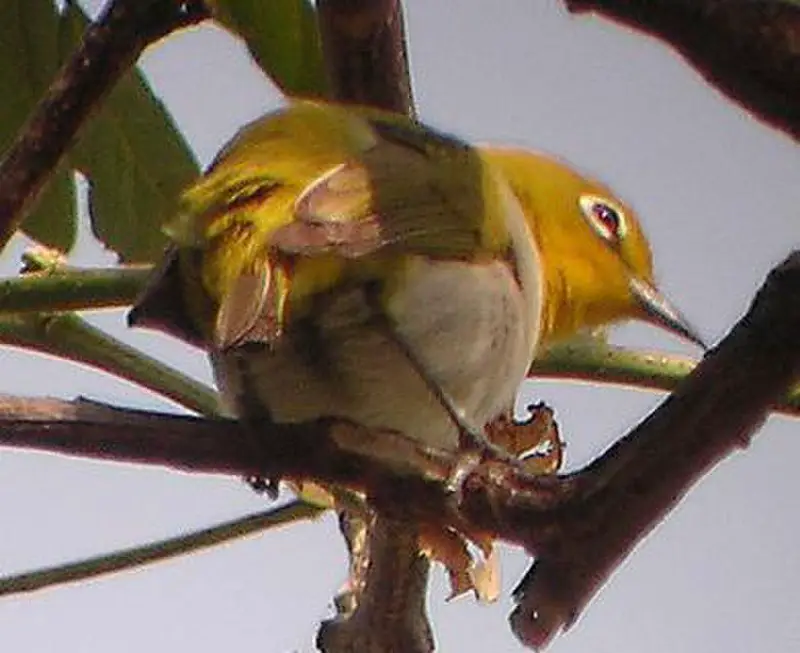
The Lowland white-eye bird belongs to the Zosteropidae family and is found in the northern part of the Philippines and the Taiwanese islands of Lüdao and Lanyu.
This species of bird prefers to inhabit subtropical or tropical moist lowland forests. They are characterized by their small size and white-ringed eyes, which are distinctive features of their appearance.
Lowland white-eyes play an important role in pollination and help maintain the ecological balance of the forest ecosystem. They feed on fruit, insects, and nectar and may form large flocks during the non-breeding season.
The conservation status of this species is currently classified as Least Concern, but habitat loss and degradation pose a threat to their survival.
Despite being a common sight in their native range, they remain an interesting and unique species to observe for birdwatchers and nature enthusiasts alike.Scientific classification:
| Kingdom | Animalia |
| Phylum | Chordata |
| Class | Aves |
| Order | Passeriformes |
| Family | Zosteropidae |
| Genus | Zosterops |
| Species | Z. meyeni |
39. Mountain Shrike
The Mountain shrike bird, also known as the grey-capped shrike, is a medium-sized bird found only in the Philippines. It has a distinct shrike shape with a lengthy tail and hook.
Its natural habitats include tropical moist montane forests and grasslands. Unfortunately, the bird is becoming rare due to habitat loss.Scientific classification:
| Kingdom | Animalia |
| Phylum | Chordata |
| Class | Aves |
| Order | Passeriformes |
| Family | Laniidae |
| Genus | Lanius |
| Species | L. validirostris |
40. Rufous Paradise Flycatcher
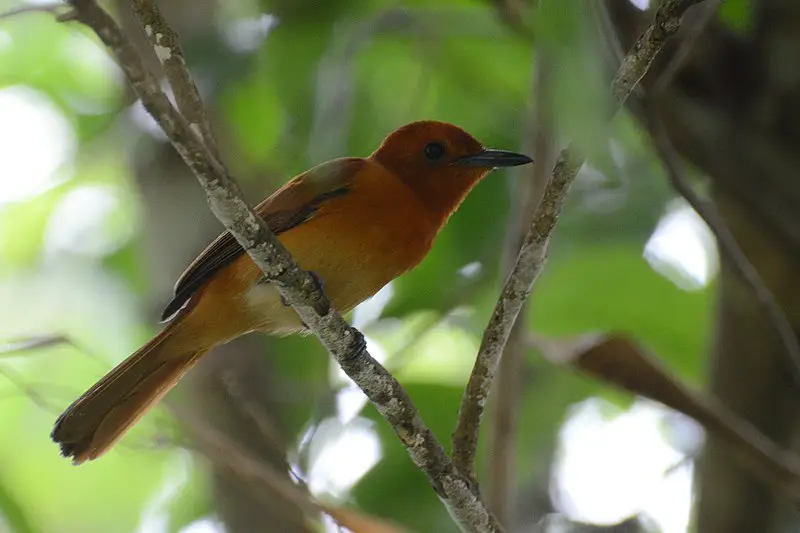
The Rufous Paradise Flycatcher, also known as the Cinnamon Paradise Flycatcher, is a bird that belongs to the family Monarchidae.
This species can be found in both Indonesia and the Philippines, living in subtropical or tropical moist lowland forests.
The bird has a distinct rufous coloring along with black and white plumes. The male and female look similar, but the female has a duller plumage.
It is a migratory bird that spends the breeding season in Indonesia and the non-breeding season in the Philippines.
The Rufous Paradise Flycatcher is known for feeding on insects and occasionally fruits. This bird has three recognized subspecies. Despite being of least concern, it is threatened by habitat loss due to deforestation.Scientific classification:
| Kingdom | Animalia |
| Phylum | Chordata |
| Class | Aves |
| Order | Passeriformes |
| Family | Monarchidae |
| Genus | Terpsiphone |
| Species | T. cinnamomea |